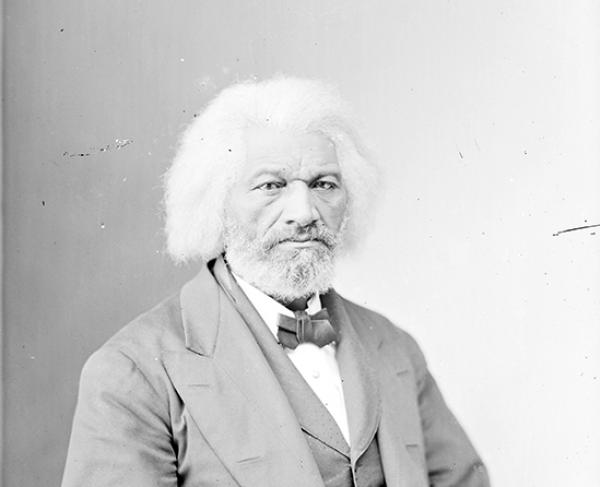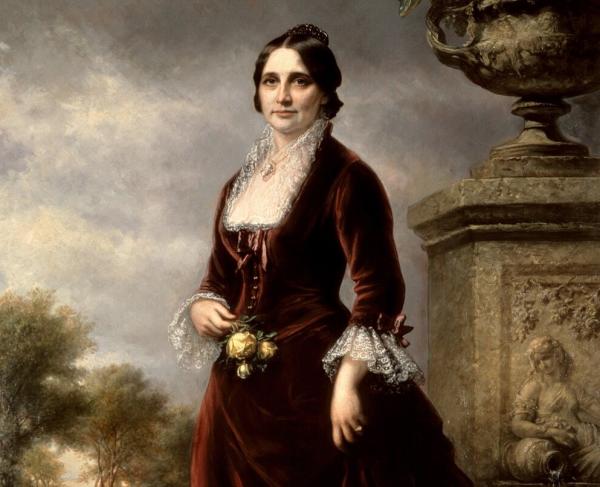Frederick Douglass

One of the most prominent civil rights figures in history, Frederick Douglass escaped from slavery and spent his life advocating for social justice, holding a place within the ranks of such prominent figures as President Lincoln, William Lloyd Garrison, Harriet Tubman and Susan B. Anthony. Douglass saw the fruits of his labor with the 13th Amendment, but was more than aware of the long struggle African-Americans would face in the years to come.
Born into slavery in Bay-side Talbot County, Maryland in 1818, Douglass, born Frederick Augustus Washington Bailey, was the son of Harriet Bailey and a white man. Separated from his mother as an infant, he lived with his maternal grandmother Betty Bailey until the age of seven.
At the age of twelve, Douglass was sent to Baltimore to serve the family of Hugh and Lucretia Auld, “a kind and tender-hearted woman.” It was Mrs. Auld who first taught him the alphabet, in spite of the fact that she was breaking the law by doing so. Douglass, aware of the power of a good education, secretly taught himself to read and write, resolving to one day escape to freedom.
In 1832, Douglass was sent out of the city to the plantation of Hugh’s brother, Thomas Auld. Thomas, in turn, sent Douglass to the notorious “negro-breaker and slave-driver” Edward Covey. Covey prided himself on his ability to crush any slave’s will to resist enslavement and beat Douglass savagely. One day when he was sixteen Douglass fought back and physically bested Covey, who never whipped him again.
On September 3, 1838, dressed in a sailor’s uniform and carrying papers provided by a free black seaman, Frederick Douglass escaped aboard a train bound for Havre de Grace, Maryland. From there, he continued to New York and eventually New Bedford, Massachusetts, where he settled. As he would remark to audiences years later: “I appear before you this evening as a thief and a robber. I stole this head, these limbs, this body from my master and ran off with them.” Douglass soon married Anna Murray, a free black woman he had met while enslaved in Baltimore, with whom he had five children: Charles, Rosetta, Lewis, Frederick Jr. and Annie, who died at the age of ten.
In 1841, while attending anti-slavery meetings Douglass met William Lloyd Garrison, founder of The Liberator and one of the most outspoken abolitionists in the country. Garrison encouraged Douglass to share his story, catapulting his career. Douglass began giving lectures at abolitionist conventions, quickly earning a reputation as an eloquent and compelling speaker.
In 1845, Douglass, with the encouragement of Garrison and Wendell Phillips, another prominent abolitionist, published his celebrated Narrative of the Life of Frederick Douglass: An American Slave. The work was an instant success. Critics charged that it was so well-written that it could never have been composed by a black man. The narrative made Douglass a widely-known public figure, even beyond abolitionist circles, which led some of his allies to fear for his safety, lest his former owner Thomas Auld come looking for his now-famous ‘property.’ Accordingly, Douglass sailed for the United Kingdom later that year. Douglass remained abroad for two years, during which time a group of English admirers made arrangements to purchase his freedom.
During the turbulent decade of the 1850s Douglass worked tirelessly for emancipation, breaking with William Lloyd Garrison over his approach (Garrison would publicly burn copies of the Constitution, which he regarded as a patently pro-slavery document) in order to publish his own newspaper, the North Star. By the Civil War Frederick Douglass was the most prominent black man in the United States. During the war Douglass consistently petitioned President Lincoln to make emancipation an explicit war aim and to sanction the raising of colored regiments. Two of his sons served in the 54th Massachusetts regiment, the first to be comprised of African-American soldiers.
After seeing his life’s work vindicated with the passage of the 13th, 14th and 15th amendments to the Constitution, Douglass held various government posts and continued to labor through the period of Reconstruction and beyond to secure civil rights for freedmen, sagely remarking, “Verily, the work does not end with the abolition of slavery, but only begins.”
Douglass moved to Washington D.C. in 1877 and became the editor of the New National Era. His wife Anna died five years later. Douglass was remarried two years later to Helen Pitts, a white feminist and the daughter of an abolitionist colleague and friend, Gideon Pitts Jr. In 1888, he became the first African-American to receive a vote for President of the United States in a major party’s roll call at the Republican National Convention in Chicago. Frederick Douglass died February 20, 1895, and is buried in the Mount Hope Cemetery in Rochester.


